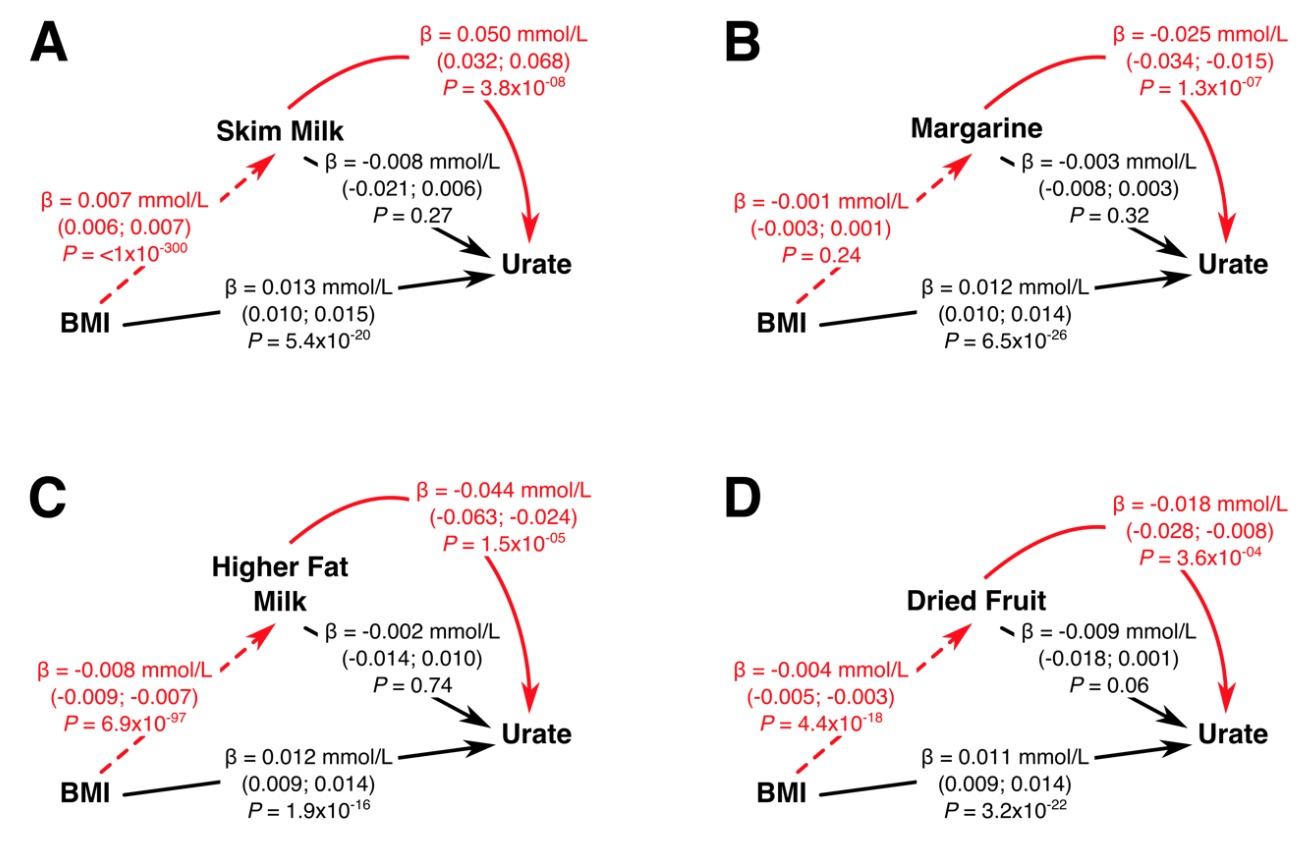Session Information
Session Type: Abstract Session
Session Time: 5:00PM-5:50PM
Background/Purpose:
Prevention of hyperuricaemia (HU) is critical to the prevention of gout. Therefore, understanding the causal relationships and relative contributions of various risk factors to HU is important. Inherited genetic variants have a significant causal role. However, the relative importance of other exposures and questions of causality are still unresolved. Here we use attributable fraction to compare the relative contribution of genetic, dietary, urate-lowering therapy (ULT) use and other exposures to HU. We also use Mendelian randomization to evaluate whether diet has a causal role in determining serum urate levels.
Methods:
Four sample sets, three from the general population (n = 419,060) and one of gout patients (n = 6,781), were derived from the Database of Genotypes and Phenotypes (Cohort 1) and the UK Biobank resources (Cohorts 2, 3, and Gout). These sample sets were comprised from individuals of European ancestry with measured serum urate levels and dietary, clinical, and genome-wide genotype information available. Dichotomised exposures to diet, the SLC2A9 rs12498742 risk variant, BMI, alcohol, diuretic treatment, sex and age were used to calculate adjusted population and average attributable fractions for HU (≥0.42 mmol/L in men and women). Exposure to urate-lowering therapy was also assessed in the gout-only cohort. Two sample Mendelian randomization using the UK Biobank cohort was conducted to test for a causal role of dietary habits in determining serum urate levels, using as instruments genetic variants previously reported as associated with dietary patterns (Cole et al. Nat Comm 2020;11:1467).
Results:
Adherence to dietary recommendations, achieving BMI (< 25 kg/m2), and absence of the SLC2A9 rs12498742 urate-raising allele produced population attributable fractions for HU of 20 to 24%, 59 to 69%, and 57 to 64%, and average attributable fraction estimates of 6 to 7%, 24 to 26%, and 22 to 24%, respectively in the three non-gout cohorts (Table). In the gout cohort, diet, BMI, SLC2A9 rs12498742, and urate-lowering treatment population attributable fractions for hyperuricaemia were 12%, 47%, 47%, and 62%, and average attributable fractions for hyperuricaemia were 3%, 14%, 14%, and 33%, respectively (Table). In the gout cohort ULT explained 34% of variance in serum urate levels, ≥10-fold higher than the other exposures tested. Mendelian randomization (Figure) demonstrated weak causal effects of two dairy-related dietary habits, margarine consumption and dried fruit consumption on serum urate levels (e.g. preferentially drinking skim milk increased urate, β = 0.050 mmol/L, P = 3.78×10-8), which were all mediated by BMI, losing significance (P ≥0.06) in multivariate models assessing the BMI-independent effect of diet on urate.
Conclusion:
The attributable fraction and Mendelian randomization data emphasise the minor role of diet in determining serum urate levels and HU. In gout the use of urate-lowering therapy was the dominant attributable fraction tested for serum urate level, with a population attributable fraction approximately 6-fold greater and an average attributable fraction approximately 10-fold greater than following healthy-eating guidelines.
 The numbers in red (solid line) derive from the first round of Mendelian randomisation, the estimated causal effect. The numbers in black represent the data from the bivariate MR analysis.
The numbers in red (solid line) derive from the first round of Mendelian randomisation, the estimated causal effect. The numbers in black represent the data from the bivariate MR analysis.
To cite this abstract in AMA style:
Topless R, Major T, Florez J, Hirschhorn J, Cadzow M, Dalbeth N, Stamp L, Wilcox P, Reynolds R, Cole J, Merriman T. The Comparative Effect of Exposure to Various Risk Factors on the Risk of Hyperuricaemia: Diet Has a Weak Causal Effect [abstract]. Arthritis Rheumatol. 2020; 72 (suppl 10). https://acrabstracts.org/abstract/the-comparative-effect-of-exposure-to-various-risk-factors-on-the-risk-of-hyperuricaemia-diet-has-a-weak-causal-effect/. Accessed .« Back to ACR Convergence 2020
ACR Meeting Abstracts - https://acrabstracts.org/abstract/the-comparative-effect-of-exposure-to-various-risk-factors-on-the-risk-of-hyperuricaemia-diet-has-a-weak-causal-effect/

